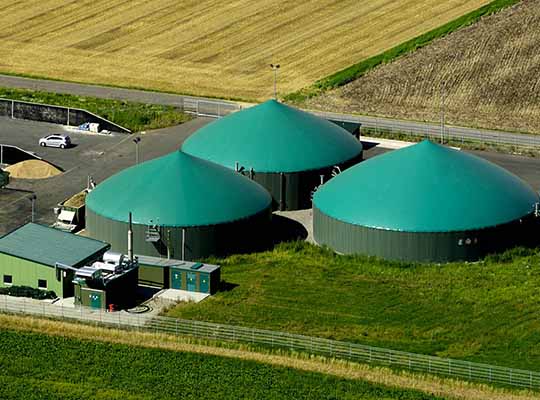Globally, Biogas is being recognized as an important component for a sustainability transition in the energy sector, there is a growing acceptance of the potential of harnessing this as a renewable energy source. Compressed Biogas (CBG), made from bio-mass feedstock such as agricultural waste, animal dung, sugarcane press mud, municipal solid waste, and so on, has characteristics similar to compressed natural gas (CNG) and hence it is an effective alternative to replace CNG in automotive, industrial, and commercial applications – the Ministry of Road Transport and Highways has approved the use of bio-compressed natural gas (bio-CNG) in motor vehicles as an alternative fuel.
India has been promoting ‘Waste-to-Energy’ projects using bio-methanation since 1982. CBG is a valuable component of India’s strategy for a sustainable and green future articulated in the Government of India’s 2018 Sustainable Alternative towards Affordable Transportation (SATAT) scheme. CBG will help support the country in minimizing dependency on fossil fuels by potentially reducing greenhouse gas emissions by 98 percent. According to the International Renewable Energy Agency (IRENA), much of the recent growth in bioenergy was provided by India, amongst other top three countries – China, increased capacity by 2 GW, UK with an increase by 900 MW, and India by 700 MW.
Under SATAT, India envisages setting up 5,000 CBG plants with an investment of about Rs Two lakh crore by 2023-24 with the production target of 15 MMT. The government has already signed initial agreements for 1,500 CBG plants to cut India’s dependency of around 85 percent on imported crude oil and over 50 percent on imported LNG. Recently, on the occasion of World Biofuel Day 2021, the Government dedicated a CBG plant in Muzzafarnagar, UP. Furthering the growth and providing sunshine to India’s CBG capacity is the decision by the sugar mills in Maharashtra to set up CBG plants to find economic stability. These have the capacity to produce 1.5 lakh tonnes of CBG per year, and gain earnings to the tune of 700 crores.
The impetus to CBG from the Government and now inquisitiveness and commitment of various agro-based industries also raises an important question for the investors and entrepreneurs. How can they make their investments more profitable? What can increase a Compressed Biogas plant’s profitability? The answer lies in advanced technology. The stakeholders and especially the OEMs in the CBG sector will have to focus on progressive technologies to maintain plant profitability to compete with other forms of energy generation and eventually become sustainable. All CBG plants need to optimize the production of biogas, whilst minimizing costs, waste, and downtime.
The main function of these CBG plants is to obtain the purest form of bio-methane out of the various wastes. Anaerobic digestion is traditionally followed to obtain biogas, but it’s the purification process that will help obtain the alternative fuels – CBG, which is the driver for the SATAT initiative.
Traditional technologies available for the biogas purification process are Pressure Swing Absorption, Water Scrubbing, Vacuum Swing Absorption, and Chemical Scrubbing. While these methods continue to exist, global technology innovators have also introduced the latest technologies for turning biogas into pure biomethane. These not only offer high-grade purity of methane but simultaneously also contribute to the ultimate aim of sustainability and ‘green’ output.
One such method of biogas upgrading is a patented three-stage membrane-based gas separation process. This technology significantly increases the recovery of biomethane, which has a corresponding effect on the profitability of biogas processing plants, hence making the upgrading process as efficient and economical as possible. The biogas to be cleaned is introduced under high pressure at one end of the membrane. The CO2 molecules are smaller than the CH4 molecules and also more soluble in polymers. As a result, they pass through the micropores of the membrane much faster and are separated from the methane.
If we look at the availability of these technologies, Evonik, the chemical industry giant has a self-developed membrane technology called SEPURAN® Green. It ensures a purity level of over 99% in the biomethane obtained from raw biogas.
Membrane separation technology offers a competitive edge owing to its high applicability, low energy consumption, excellent selectivity, readily designed modules, and, consequently, lower operating costs. The membrane separation technology takes up very little space and heavily reduces the installation time and costs. The process does not produce waste or emissions, and it does not necessitate the use of auxiliary materials such as water or sorbents. For a CBG plant, the membrane separation technology reduces the load drying, recycling, and operation while working in its primary feature of separation.
While cost is an important factor in the selection of biogas purification methods for a CBG plant, it is also critical that the various OEMs and technology providers keep in mind the importance of employing Sustainable and GREEN technologies in order to make CBG a truly sustainable energy source in India.
While the Indian Government has provided enablers through policy making and laying down foundations of a healthy and interested ecosystem, it is technology innovation that will give the much-needed push to move towards large-scale successful and profitable CBG plant set-ups in India.











